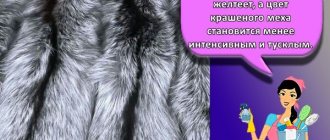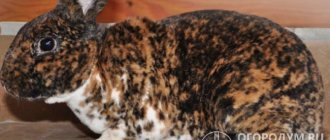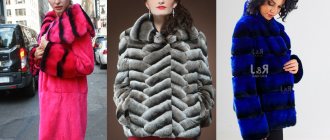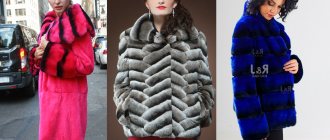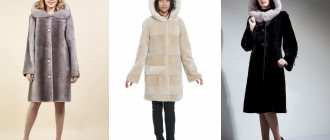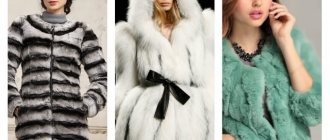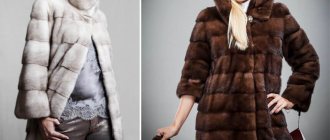Things made from natural fur are not cheap, so they are bought not for one season, but for several years. During prolonged wear, the appearance of the product suffers: the fur wears out and becomes dull. How to restore your favorite fur coat to its former glory? Of course, you can take it to the dry cleaner, which means spending money, or you can dye the fur at home, thereby breathing new life into the fur item.
During prolonged wear, the appearance of the fur coat suffers: the fur wears out and becomes dull. One possible solution to the problem is to dye the fur of the fur coat in a different color.
Astrakhan fur
Dyeing astrakhan fur at home does not require special knowledge, skills and abilities. Astrakhan fur can (and should) be dyed black. The paint is applied to damp pile and kneaded with hands to ensure even distribution, after which the product can be set aside for the time specified in the manufacturer’s instructions. After the period during which the paint should “set” has expired, the product is washed under warm running water, laid out on a flat, slightly inclined surface and, using simple manipulations, is cleaned of excess moisture. After complete drying, the pile is combed with a regular comb in the desired direction.
Tips and tricks
When dyeing fur, it is important to know some nuances:
- The fur you decide to dye should not be too shabby.
- Only clean pile will stain well, so it must be cleaned first.
- The yellowed white fur of the Arctic fox can be simply lightened.
- Before using any coloring agent, be sure to test it on an inconspicuous area.
- When painting, you can hide some flaws and defects.
- Instead of full-fledged paints, sometimes you can use small folk tricks. For example: the fur of a red or steppe fox can be quickly and painlessly renewed using a strong solution of potassium permanganate. In this case, use a small sponge. It needs to be dipped into the solution and passed over the villi, being careful not to touch the core.
- After dyeing and drying, the fur must be combed so that it becomes fluffy again.
- Using tinting shampoo, you can create a unique decor on your fur product. You just need to show a little imagination.
Now you know whether it is possible to dye the fur of the Arctic fox and other fur-bearing animals, and you can also imagine the technology of this process. The main thing is to strictly follow all instructions. And your favorite and cozy fur coat will delight you with its warmth and impeccable appearance for some time to come. If you do not dare to take such an important step as dyeing fur, then contact specialists at a dry cleaner or workshop for repairing fur products.
Fox fur
Due to the similar structure of the pile, dyeing fox fur at home is similar to that of a rabbit. Particular attention should be paid to the choice of shade: the most common mistake of people who take on the task of dyeing expensive furs on their own is failure to follow the rules for choosing the required tone. As last time, the substance should be a tone lower than the original color.
After the procedure, you can use the balm (included with the dye): it will give the product a special shine and silkiness. Dry naturally, without hair dryers, radiators or heaters. Preferably on a horizontal surface, securing the edges of the product with pins.
What hair dyes can you use?
From a large number of household cream paints, you need to choose paints that provide dyed fur with good resistance to light, water and mechanical stress. When painting mink fur, depending on whether the fur is old or new, the paint consumption is small. If we need to dye skins with long-haired fur (Arctic fox, fox, silver fox or sable), paint consumption increases significantly, especially when dyeing light skins in dark colors and new fur. In this case, the issue of price is acute.
For dyeing mink, muskrat and other fur skins, the following stable household cream hair dyes have proven themselves to be effective: FARA, IMPRESION +, PRESTIGE. Dyed items retain their color for 2–3 years, are not washed off with water, and are almost indistinguishable in color from natural, undyed skins. Paints Fara, Impression, Prestige
Sheepskin fur
Unlike previous methods, dyeing sheepskin at home is a little different. To distribute the paint evenly over the surface, the product is placed in a solution consisting of aniline dye and chemicals and heated at 40-50 degrees until the material acquires the desired color. But due to certain difficulties, this method is not very popular among ordinary people. Fortunately, nowadays people who want to dye sheepskin are offered an alternative in the form of aerosol dyes.
The process is carried out outdoors. Do not neglect personal protective equipment, because... in some cases, the coloring matter contains elements that can cause harm to human health (after drying, under the influence of UV rays, their harmful effects are neutralized).
Preparing for painting
To dye fur, you must first prepare it. During wear, dirt accumulates on the surface of the product: particles of dust and grease. You cannot wash fur items using conventional methods, but before painting you need to thoroughly clean the surface to be treated so that the paint lays evenly and penetrates well into the fibers. What to do? You should carefully treat the fur with an alkaline solution , which will dissolve fat and remove dust particles.
Before painting, the fur should be cleaned: carefully treated with an alkaline solution
It’s easy to prepare the mixture: add 3 tsp to 1 liter of water. salt, 2 tsp. soda, 1 tbsp. l. dishwashing detergent and 5 g of ammonia. But here is another option: water, vinegar and alcohol are taken in equal proportions. All components of the solution must be thoroughly mixed, the dry components must be completely dissolved.
You can clean a variety of types of fur with this liquid, for example, mink, silver fox, arctic fox, fox or rabbit. It is possible that after such simple cleaning the appearance of the product will improve and the need for painting will simply disappear.
Perhaps after cleaning the appearance of the fur coat will improve and you will change your mind about dyeing it.
Before applying the resulting solution to the fur, you need to treat its underside - the inner side. The fact is that skins can crack or become deformed after getting wet. Therefore, after the color is restored, you may be in for an unpleasant surprise - the product will decrease in size or simply lose its shape. To prevent this from happening, it is best to properly treat the lining with glycerin or any nourishing and fatty cream , which will require carefully ripping open the lining.
After processing the skin, the fur is carefully laid out on a flat surface and an alkaline solution is applied. It is best to distribute it over the surface of the product using a brush. With this treatment, the liquid will be distributed along the entire length of the villi. Then the product must be thoroughly rinsed from the fur and proceed directly to dyeing.
Coloring stages
First you need to prepare for staining.
You need to put the fur coat on the table. If only the collar needs dyeing, it is better to protrude it. It is also important to test the paint tolerance on a small section of the product. To do this, the composition is applied to the sample. If after the procedure there is no damage to the villi or inner parts, and the color suits you, you can begin painting the product. For the procedure you need to use a special brush. Apply the paint evenly so that the shade is even on both the top and deep layers. After 40 minutes, remove the product with warm water. It is not necessary to paint a fur coat in one tone - highlighting will be an original solution. To do this, the painted ends are wrapped in foil. After some time, the foil is removed. Highlighting looks luxurious and rich. This staggered procedure also looks original. It is recommended to carry out the procedure with a suede treatment product.
Note!
Before the procedure, you need to study the characteristics of the material; some types, such as mink, are difficult to dye. Therefore, more helmets will be required.
How to clean an Arctic fox collar at home?
“If you love to ride, love to carry a sled,” says a famous Russian proverb. Such an attribute of luxury as an arctic fox collar requires special care. And this concerns not least cleaning.
Fortunately, everyone has everything for this:
- Fatty deposits can be easily removed using an aqueous solution of ammonium hydroxide. To do this, dilute it in regular tap water. The result will be an almost perfect stain remover;
- Dog shampoo or even household detergent (dissolved in a small volume of tap water) will also do the job well. The main thing is not to use soap-based chemicals, since they are very difficult to wash off;
- Hydrogen peroxide, available in every first aid kit, will effectively remove any stains if sprayed through a spray bottle;
- An unusual but effective method is to use... gasoline. This fuel has proven its excellent cleaning properties. In addition, there is no need to wash it off: it quickly evaporates on its own
.
Precautions during operation
Any dyeing (fur, fabric, hair) is work involving chemicals. Therefore, some precautions must be taken. You need to choose only high-quality dye. Usually such things are expensive. But it’s worth paying money, because cheap paints contain toxic substances that cause allergies.
If possible, the painted skin should not come into contact with the skin. This is why transforming an old hat is not the best option for those who suffer from allergies and have sensitive skin.
A spray bottle that is used to spray paint cannot be used for other purposes, such as spraying indoor plants. After painting, the spray bottle should be thoroughly dried. You can’t spray paint just like that, “in the air,” because you can get it in your eyes. Children and pets should not be in the room during work.
Dyeing fur items is a method of restoring old items , which allows lovers of fur clothing to look beautiful and stylish. If you use high-quality paint and work carefully, the painted item will become a real highlight of your wardrobe and will certainly attract attention. Clothing made of fur in original colors suits both young girls and respectable ladies. You should not use too bright colors to avoid looking tasteless.
Features of painting a mink coat
A mink coat has an excellent appearance. However, over time it also begins to fade, so painting the fur coat is inevitable. The procedure should not cause difficulties, adhere to the following scheme:
- First you need to clean the fur from dirt, then apply a rich cream to the inside.
- Moisten the villi with water by spraying them with a spray bottle.
- It is also better to apply paint using a spray bottle, after diluting it with water.
- Comb the fur with a comb and wait about half an hour.
- Remove the paint with warm water and shampoo, then rinse with conditioner and rinse the product again.
- Re-treat the inside with cream, comb the villi in the desired direction.
- Hang the fur coat to dry on a hanger.
The process of dyeing natural fur with hair dye
Before dyeing, a fur skin or a fur cap for a hat, which you have cut out and sewn from whole skins or worn fur (an old hat or collar), must be degreased by washing, since oily and dirty hair does not dye well. Unpainted areas and stains appear.
Prepare water at room temperature in a cup, add washing powder in a small amount and wash gently. The skins should already be tested for water, as sometimes the skins swell and tear from water. To prevent the skins from tearing, wash them without sudden movements and try not to twist them when squeezing. After washing, the skin is rinsed in clean warm water, lightly wrung out and prepared for painting. Paint preparation process
The paint is prepared according to the instructions included in the box. Squeeze the hair dye and oxidizing agent (peroxide) out of the tube into a separate bowl and mix everything well. The paint is spread onto the skin or a sewn fur cap using a sponge and rubbed into the fur. The skin is rolled up and placed in a cup. After 10 - 15 minutes they come up and rub the paint well into the fur again. They constantly watch how the skin is dyed. After half an hour, darkening of the fur appears (if the mink is dyed brown), the longer the dyeing, the darker the color. Worn fur dyes faster.
At the end of painting, the skin is rinsed in clean warm water, and then washed with powder in warm water, rinsed several times until clean water. The skin is wrapped in a towel and gently squeezed without twisting, so as not to tear. Then the skin needs to be dried.
Some nuances of choosing paint
Important! First of all, consider the size of the product or the desired area of painting. The spray consumption will depend on this. Salamander fur paint in aerosol is easier to spray and dries very quickly. But aerosols are not so easy to reach under the fur. In order to evenly tint the entire product and the skin, it is better to process it completely using the dipping method.
Salamander faux fur paints are no less practical and durable. In terms of cost, they are practically no different from sprays and aerosols for natural fur. There are not many shades offered, mostly only the most popular colors, close to natural and classic. If you are not confident in your knowledge and skills, it is better to use the services of specialized workshops.
Caring for dyed fur
As a result of painting fur skins, individual pieces, fur caps for hats with persistent household cream hair dyes, carried out using the spread method, by rubbing the paint into the fur, we obtain a stable color. The paint is resistant to light, water and mechanical stress when wearing fur for a long time. Such items do not require special care; the requirements are the same as for any fur product.
The requirements for fur dyed by spraying are completely different. The color is not particularly durable, so it is better to protect such a product from the influence of light, water, mechanical stress and elevated temperature.
In order for the dye to stick better and the fur to shine, it can be treated with a special balm for the care of dyed hair. After this treatment, the fur becomes softer and fluffier.
Fur products require daily care, combing more often, and require thorough cleaning. Much depends on proper storage. Fur should be covered and stored in a dark place.
Color preservation
Any fur of fur-bearing animals sooner or later loses its shine, shade and overall attractiveness. In order to keep it in the appropriate form for as long as possible, you need to take proper care and care for the condition of the fur.
- Do not forget to periodically comb the villi with a special brush.
- Always dry your fur coat thoroughly if it is wet.
- Be sure to clean your products regularly. If you notice a stain or worn areas, for example on the sleeves, you should think about cleaning and removing the dirt.
- At the end of the season, be sure to inspect the entire product for contamination. You should not hang uncleaned things in the closet.
- Be sure to put a cover on your fur outerwear before hanging it for storage.
By following these simple rules, you can maintain the brightness of the color and shine of the pile for as long as possible.
Leave your comment:
How to dye faux fur
There are no differences in the painting of artificial and natural materials. In the first case, it is possible to experiment by choosing any color. Cleaning such fur is carried out with ordinary soapy water, which is distributed over the entire surface of the product with a sponge. Then you need to treat the villi with paint of the shade you like. Drying is also carried out without the use of a hair dryer or battery.
Selection of shades for different fur colors
You need to dye the fur in a tone that will be an order of magnitude darker than the existing one. For example, if you need to dye brown mink fur, be sure to use a darker dye. FARA paint – dark brown No. 502 is suitable for natural brown mink. Mink fur, like any other, is dyed differently. New fur that has not been exposed to sunlight (new skins) dyes very poorly; you have to increase the concentration of dye by adding a darker one.
So, for example: you can add half a tube of black paint No. 501 to dark brown paint FARA No. 502. You can increase the concentration even more by adding half a tube of dark brown paint No. 502 to a tube of black No. 501.
New mink or muskrat fur does not dye well, so often after drying it has to be re-dyed in the same way to achieve dark shades. Old (worn) fur of mink, muskrat and other animals, which has been exposed to sunlight, dyes much better and the longer the fur is worn, the more intense the color. Within 30 minutes to an hour, the skin is completely painted with dark brown FARA dye No. 502 or No. 501. Tinted shampoo IRIDA
Light tones of fur, for example: gray or blue mink, are better tinted in the same tone with hair dye - IRIDA. For yellow or white mink it is also better to choose paint to match. After dyeing, the fur is renewed, the color becomes brighter and more saturated. Light new skins are difficult to dye in dark tones; it is often necessary to repaint them, increasing the concentration according to the method described above. There are no such problems with old light fur; it can be easily dyed black or brown.
It is better to tint long-haired fur (arctic fox, fox) in a natural color, choosing paint according to color. When painting in dark colors, and even when the skins are new, much more paint is used.
How to care for a fur product after dyeing
If the fur was dyed using a spread method (using paint), the result would be a color that is resistant to moisture and ultraviolet radiation. The shade will remain for another 2-4 seasons. The main thing in a painted product is not to get caught in the rain. The wet pile should be immediately dried with a stream of cool air and combed.
If the fur is painted by spraying, that is, using aerosol paint, the color will not last long.
After all, such a coloring agent only tints the pile. The paint will remain on your hands and objects in contact with the fur (on your bag, belt). The shade will easily come off if your fur coat is caught in heavy snow. The wet pile should be dried with a stream of cold air and combed. Faded areas can be re-touched with spray.
Painting methods: what to paint with
Fox fur can be treated with a solution of potassium permanganate to return the original color. With other materials it is unlikely to be possible to use improvised methods. For the procedure, hair and suede dyes and brighteners are used. Ammonia products are the most affordable and easy to use method. To achieve the desired effect, you only need one package of this product. It is better to take the color 1-2 shades darker than the material. For example, when a mink coat was black and it was dyed white, the result may be yellow.
Suede dye is only suitable for painting certain areas of the product, for example, the tips of the pile. High quality products are suitable for lightening - others will be less effective. Aerosol paints are suitable for large products - they are easier to apply.


